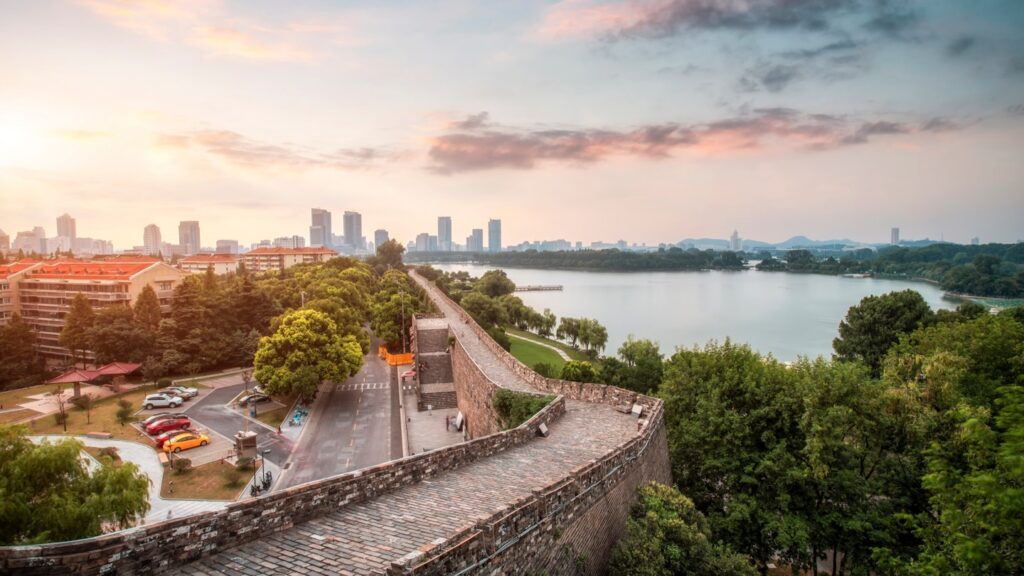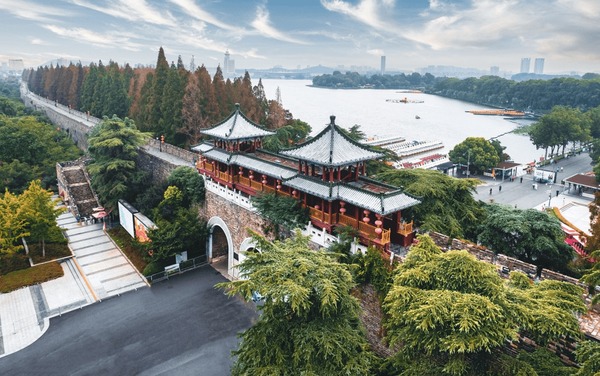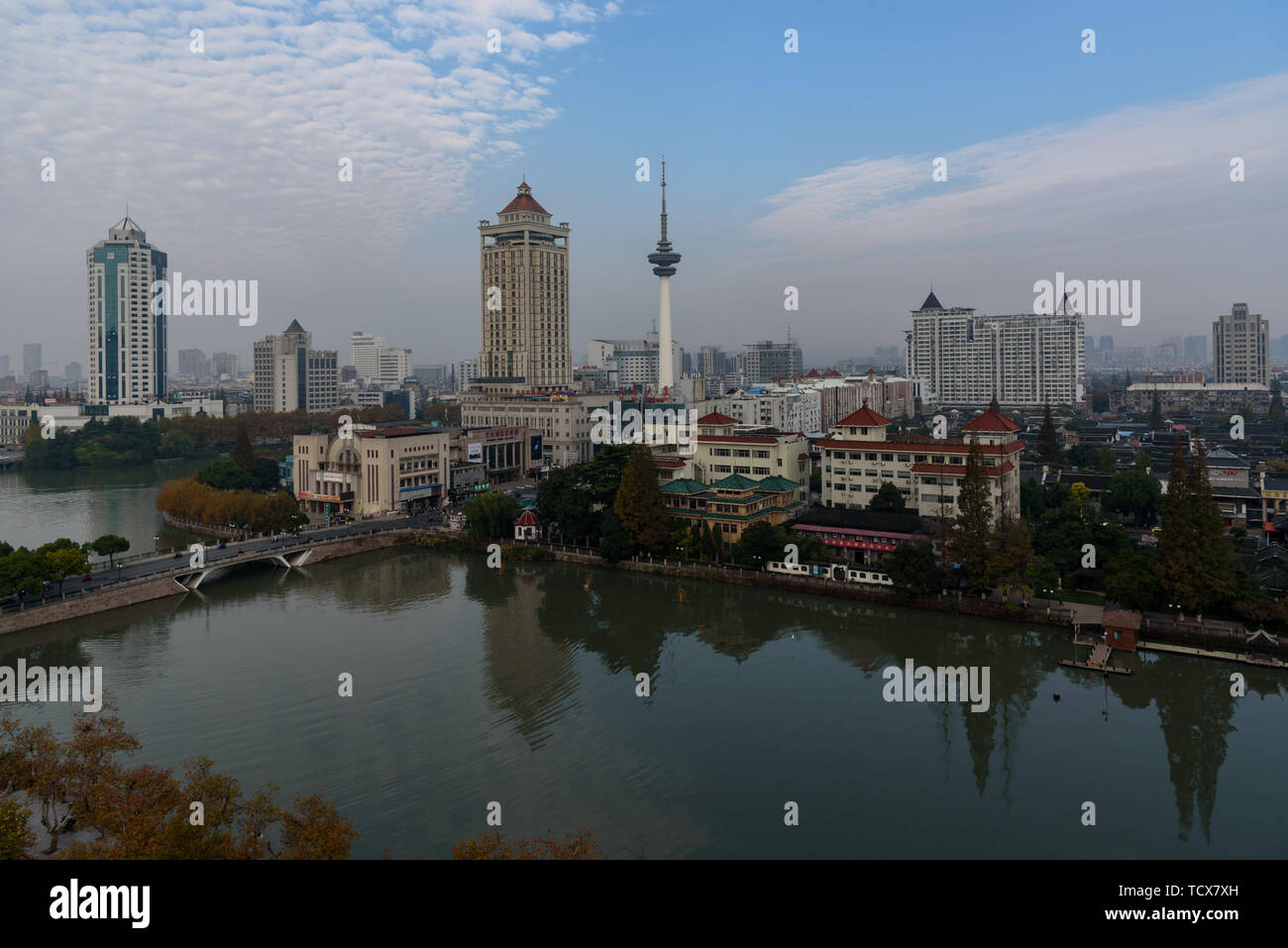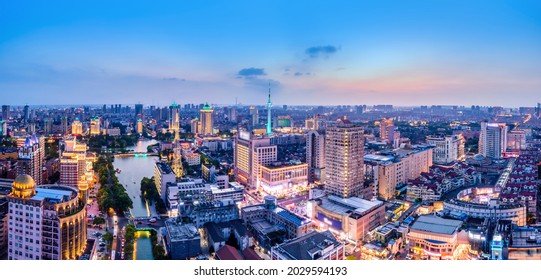Discover the Secrets of Nantong City Wall: A Journey Through History and Beauty

An Essential Guide to Visiting Nantong City Wall
Nestled in the vibrant city of Nantong, the Nantong City Wall stands as a remarkable testament to the region’s rich history and architectural prowess. What sets this ancient structure apart is its unique blend of formidable defense and stunning aesthetic, making it not only a historical relic but also a picturesque backdrop for visitors. The wall, constructed during the Ming Dynasty, offers a glimpse into the past, showcasing intricate designs that reflect the artistic spirit of that era.
In this essential guide, you’ll discover everything you need to know for an enriching visit to the Nantong City Wall. From practical tips on transportation and nearby accommodations to highlights of local attractions and dining options, we’ve curated a comprehensive resource for international travelers. Whether you’re looking to stroll along the wall for panoramic views of the city or delve into its fascinating history, this guide will help you uncover the treasures that await at Nantong City Wall. Prepare for an adventure that merges culture, history, and breathtaking scenery!
In This Guide
- An Essential Guide to Visiting Nantong City Wall
- The Rich History and Legends of Nantong City Wall
- Main Highlights: What You Absolutely Can’t Miss
- Planning Your Visit: A Practical Guide
- Tickets: Prices, Booking, and Tips
- How to Get There: A Complete Transportation Guide
- Local Cuisine and Accommodation Nearby
- Frequently Asked Questions
- Final Thoughts on Your Trip
The Rich History and Legends of Nantong City Wall
A Journey Through Time: The History of Nantong City Wall
Nantong City Wall, an emblem of resilience and history, reflects the rich tapestry of Nantong’s past. From its inception to modern-day significance, this ancient structure has witnessed pivotal moments and has been steeped in legends that continue to inspire awe among locals and travelers alike.
The Origins: A Fortress of Protection
Construction of the Nantong City Wall began in the early Ming Dynasty (1368-1644) as a defensive measure against invasions. Strategically located along the Yangtze River, Nantong served as a crucial military outpost. The wall, built primarily of local materials such as clay and bricks, was designed to withstand artillery attacks and raids. Its robust structure was a testament to the engineering prowess of that era, ensuring the safety of its inhabitants and the flourishing trade that passed through the region.
The Ming and Qing Dynasties: Expansions and Modifications
Throughout the Ming and Qing Dynasties (1368-1912), the wall underwent several expansions and repairs. The tumultuous periods of warfare and rebellion necessitated these enhancements, ensuring the wall remained a formidable barrier. Notably, during the Taiping Rebellion in the mid-19th century, the city wall played a critical role in safeguarding Nantong against rebel forces, showcasing its strategic importance in times of crisis.
The Fall and Revival: A Modern Perspective
As the 20th century approached, the significance of the city wall began to decline with the advent of modern warfare and urban development. Portions of the wall were dismantled to make way for new infrastructure. However, in recent decades, there has been a concerted effort to preserve what remains of this historic monument. Restoration projects have not only aimed to maintain the physical structure but also to educate future generations about its historical significance.
Legends of Nantong: Stories That Endure
The Nantong City Wall is not just a relic of the past; it is also a backdrop for enchanting tales that enrich its history.
The Guardian Spirit
One popular legend tells of a guardian spirit that protects the city from harm. According to local lore, a benevolent deity resides within the wall, safeguarding the city from invaders and natural disasters. It is believed that on stormy nights, one can hear whispers carried by the wind, thought to be the spirit’s way of communicating warnings to the citizens.
The Lost Treasure
Another captivating story revolves around a hidden treasure buried within the wall. As the legend goes, during the Ming Dynasty, a wealthy merchant buried his riches within the wall for safekeeping. However, he perished in a raid before he could retrieve it. To this day, treasure hunters are said to scour the vicinity, hoping to unearth this long-lost fortune.
Conclusion: A Symbol of Heritage
Today, the Nantong City Wall stands not only as a historical monument but also as a symbol of the city’s enduring spirit. Visitors are encouraged to explore its remnants, walk along its ancient paths, and immerse themselves in the stories that echo through time. Whether you are drawn by its history, intrigued by its legends, or simply seeking a picturesque spot to reflect on the past, Nantong City Wall offers an unforgettable glimpse into the rich heritage of this vibrant city.

Nantong City Wall.
Main Highlights: What You Absolutely Can’t Miss
Embrace History at the Nantong City Wall
Nantong’s City Wall (南通城墙) is a magnificent testament to the city’s storied past. As you explore this historical structure, you’ll encounter a blend of stunning architecture, panoramic views, and intriguing stories waiting to be discovered. Here are the main highlights you absolutely can’t miss during your visit.
1. The South Gate (南门)
The South Gate is one of the most impressive entrances to the city wall. This grand structure, with its towering stonework and intricate carvings, offers a glimpse into ancient military architecture. Practical Tip: Arrive early in the morning to capture the soft glow of sunrise illuminating the gate and enjoy a quieter experience before the crowds arrive.
2. City Wall Walkway
Stroll along the well-preserved walkway atop the wall for breathtaking views of the surrounding cityscape. The elevated path provides a unique perspective on Nantong’s blend of modern and historic architecture. Practical Tip: Wear comfortable shoes, as the pathway can be uneven in places. A late afternoon visit will reward you with stunning sunset vistas.
3. The Watchtower (望楼)
Don’t miss the historical watchtower, which stands as a sentinel over the city. This structure not only served as a lookout point but also as a symbol of defense against invaders. Climb to the top for a panoramic view that stretches across the city and the Yangtze River. Practical Tip: Bring a camera and a pair of binoculars to appreciate the distant landscapes and urban sights.
4. Interpretive Displays
Throughout the city wall, you’ll find informative displays that delve into the history of Nantong and the significance of the wall itself. These exhibits provide context to your visit and highlight the architectural techniques used in its construction. Practical Tip: Take your time to read the displays; they often contain fascinating anecdotes and historical tidbits that enrich your understanding of the site.
5. The Northern Ramparts
Venture to the northern segment of the wall for a more tranquil experience. Here, you can enjoy the beauty of the city park that hugs the base of the wall, where locals gather for leisure activities. This area is perfect for a leisurely stroll or a quiet moment of reflection. Practical Tip: Pack a picnic to enjoy in the nearby park area, soaking in the historical ambiance while indulging in local snacks.
6. Nighttime Illumination
If your schedule allows, return to the city wall after sunset. The wall is beautifully illuminated, creating a magical atmosphere that highlights its architectural features against the night sky. Practical Tip: This is a wonderful time for photography, so ensure your camera is ready to capture the enchanting scenes.
7. Nearby Cultural Attractions
Complete your visit by exploring nearby cultural sites, such as the Nantong Museum or the bustling local markets. These locations provide deeper insight into the city’s heritage and vibrant arts scene. Practical Tip: Consider joining a guided tour to maximize your experience and gain insider knowledge about the city’s history and culture.
With these highlights in mind, your visit to the Nantong City Wall promises to be an unforgettable journey through time, offering both breathtaking views and a rich tapestry of history.

Nantong City Wall.
Planning Your Visit: A Practical Guide
Best Time to Visit
Nantong City Wall is best experienced in the spring (March to May) and autumn (September to November) when the weather is mild and the scenery is particularly pleasant. During these seasons, temperatures range from 15°C to 25°C (59°F to 77°F), making it ideal for outdoor exploration. Avoid visiting during the peak summer months (June to August), as temperatures can rise above 30°C (86°F) and humidity levels are high, potentially making your visit uncomfortable.
Recommended Itinerary
Morning:
– Start your day early with a visit to the Nantong City Wall. Aim to arrive by 9 AM to avoid crowds and enjoy the tranquility of the site.
– Explore the various gates and towers along the wall, taking your time to appreciate the historical architecture and significance.
Lunch:
– Head to a nearby local restaurant to savor traditional Jiangsu cuisine. Dishes like Nantong fried rice and steamed buns are highly recommended.
Afternoon:
– After lunch, take a leisurely stroll through the surrounding gardens or visit a local museum to deepen your understanding of Nantong’s history.
– If time allows, consider a boat trip on the Yangtze River for a unique perspective of the city.
Evening:
– As the sun sets, return to the City Wall for a stunning sunset view. The ambiance transforms as the wall is beautifully lit up after dark.
Photography Tips
- Golden Hour: For the best lighting, visit during the golden hour, just after sunrise or before sunset. The soft light enhances the beauty of the wall and its surroundings.
- Wide-Angle Lens: Bring a wide-angle lens to capture the full extent of the wall and its impressive gates.
- Details Matter: Don’t forget to photograph intricate details, such as carvings and inscriptions on the wall, as these tell the story of its history.
- Panorama Shots: If you have a smartphone or camera with a panorama mode, use it to capture sweeping views of the wall against the skyline.
What to Wear
- Comfortable Footwear: Since exploring the City Wall involves walking and possibly climbing, wear sturdy and comfortable shoes.
- Weather-Appropriate Attire: Dress in layers, especially if you’re visiting in spring or autumn. A light jacket may be necessary in the cooler mornings and evenings.
- Sun Protection: If you’re visiting in summer, wear a wide-brimmed hat and sunscreen, as you’ll be exposed to direct sunlight for extended periods.
Insider Tips
-
Timing Your Visit: To avoid the crowds, try to visit on a weekday rather than the weekend. This allows for a more peaceful experience and better photo opportunities.
-
Local Guide: Consider hiring a local guide or joining a tour. They can provide valuable insights and stories that enhance your appreciation of the City Wall’s history.
-
Nearby Attractions: Don’t miss the nearby Nantong Museum and the beautiful gardens that surround the wall. These locations add value to your visit and can easily fill a day of exploration.
-
Stay Hydrated: Bring water with you, especially during warmer months. There are limited vending options on-site, and staying hydrated is essential for an enjoyable visit.
-
Cultural Events: Check the local calendar for any cultural events or festivals happening during your visit. Participating in local festivities can provide a deeper connection to the city and its heritage.
With this guide in hand, your visit to Nantong City Wall promises to be a memorable experience, rich in history and beauty. Enjoy your journey!

Nantong City Wall.
Tickets: Prices, Booking, and Tips
When planning your visit to the Nantong City Wall, it’s essential to know the ticketing details to ensure a smooth experience. Below is a breakdown of ticket types, prices, and what each ticket includes.
| Ticket Type | Price (CNY) | Includes |
|---|---|---|
| Adult Ticket | 30 | Entry to the City Wall, informational brochure |
| Student Ticket | 15 | Entry to the City Wall (valid student ID required) |
| Senior Ticket | 15 | Entry for seniors aged 65 and above |
| Family Package | 80 | Entry for two adults and two children |
Booking Information
To book your tickets for the Nantong City Wall, you have several options:
-
Online Booking: Tickets can be conveniently purchased through popular travel platforms such as Trip.com or through the official Nantong tourism website. Booking online allows you to avoid long queues and secure your preferred visiting time.
-
On-site Purchase: While you can buy tickets directly at the entrance, it is advisable to book in advance, especially during peak tourist seasons or weekends, when crowds can be substantial.
Tips for a Smooth Visit
- Plan Ahead: Given the historical significance of the Nantong City Wall, it’s a popular attraction. Booking your tickets in advance will save you time and ensure availability.
- Check for Discounts: If you’re a student or a senior citizen, don’t forget to bring your ID to enjoy the discounted ticket prices.
- Timing Your Visit: The best times to visit are early morning or late afternoon, which not only helps you beat the crowds but also offers the best light for photography.
By following these guidelines, your journey to the Nantong City Wall will be both enjoyable and hassle-free!
How to Get There: A Complete Transportation Guide
Arriving at Nantong City Wall
Visiting the Nantong City Wall is an enriching experience, steeped in history and architectural beauty. Here’s a comprehensive guide on how to reach this iconic site and navigate the surrounding area.
From the Nearest Major City
Getting to Nantong from Shanghai:
- By Train:
- Duration: Approximately 2-2.5 hours.
- Cost: Around ¥60-¥150 (USD 9-22) depending on the class of service.
-
Details: High-speed trains operate frequently from Shanghai Hongqiao Railway Station to Nantong Railway Station. It is advisable to book tickets in advance through apps like Trip.com or at the station. Once you arrive at Nantong Railway Station, you can take a taxi or local bus to the City Wall.
-
By Bus:
- Duration: About 3-4 hours.
- Cost: Approximately ¥60 (USD 9).
-
Details: Long-distance buses leave from various locations in Shanghai, such as Shanghai South Bus Station, and arrive at Nantong Bus Station. From there, you can take a taxi or local transportation to the City Wall.
-
By Car:
- Duration: Roughly 2 hours depending on traffic.
- Cost: Varies based on fuel and tolls.
- Route: The most direct route from Shanghai is via the G40 Expressway. Renting a car can provide flexibility for exploring more of Nantong and its surroundings.
Getting to Nantong from Nanjing:
- By Train:
- Duration: Approximately 1.5 hours.
- Cost: Around ¥50-¥100 (USD 7-15).
-
Details: Frequent trains operate from Nanjing Railway Station to Nantong Railway Station. After arriving, a taxi or local bus can take you to the City Wall.
-
By Bus:
- Duration: About 2.5 hours.
- Cost: Approximately ¥40 (USD 6).
- Details: Buses depart from Nanjing’s various bus stations, arriving at Nantong Bus Station. Similar to the train, you can continue your journey to the City Wall via taxi.
Getting Around the Scenic Area
Local Transportation Options:
- Walking:
-
The Nantong City Wall is located within a pedestrian-friendly area. Walking allows you to appreciate the historical architecture and scenic surroundings at your own pace.
-
Bicycles:
-
Bicycle rentals are available nearby. This is a fantastic way to explore the area, with designated bike lanes enhancing your experience.
-
Taxis and Ride-Sharing:
-
Taxis are readily available and cost-effective for short distances. Ride-sharing apps, such as Didi Chuxing, are also popular and provide an easy way to navigate the city.
-
Public Buses:
- Nantong’s public bus system is extensive and budget-friendly. Bus routes are well-marked, making it easy to reach various attractions around the City Wall.
Final Tips
- Language: While many signs are in English, having a translation app or a few key phrases in Mandarin can enhance your experience.
- Best Time to Visit: The City Wall is open year-round, but visiting in spring or autumn is ideal due to pleasant weather.
- Explore Nearby Attractions: Don’t miss nearby sites such as the Nantong Museum and the Sutong Yangtze River Bridge, which can be easily reached by local transportation.
With this guide, you are well-equipped to make the most of your visit to the Nantong City Wall, immersing yourself in the rich history and culture of this beautiful area. Enjoy your travels!

Nantong City Wall.
Local Cuisine and Accommodation Nearby
Exploring the area around Nantong City Wall offers not only a glimpse into the city’s rich history but also an opportunity to indulge in some delightful local cuisine and comfortable accommodations.
Taste the Local Flavors
-
Nantong Crab (南通蟹): Known for its sweet and tender meat, Nantong crab is a must-try when visiting the city. Typically served steamed with a dipping sauce made from vinegar and ginger, this dish highlights the freshness of local seafood.
-
Steamed Buns (包子): These fluffy, pillowy buns come filled with a variety of ingredients, from savory pork to sweet red bean paste. They make for a perfect snack while exploring the city wall and are commonly found at street vendors.
-
Nantong Fried Rice (南通炒饭): A local twist on the classic fried rice, this dish is stir-fried with fresh vegetables, succulent shrimp, and aromatic spices. It’s a hearty meal ideal for refueling after a day of sightseeing.
-
Eight Treasures Congee (八宝粥): This sweet rice porridge is cooked with a medley of ingredients such as red beans, lotus seeds, and jujubes. Served warm, it’s a comforting dish that locals enjoy for breakfast or as a dessert.
Where to Stay
-
Luxury Option: Jinling Hotel Nantong (金陵大酒店)
Situated close to the city center, this five-star hotel offers opulent rooms with stunning views of the Yangtze River. Guests can enjoy amenities such as a full-service spa, fine dining, and a well-equipped fitness center. -
Boutique Choice: Nantong Shanshui Hotel (南通山水酒店)
This charming boutique hotel blends modern comforts with traditional Chinese design. Located just a short stroll from the city wall, it provides a unique and personalized experience, complete with a cozy café serving local snacks. -
Budget-Friendly: 7 Days Inn Nantong Xinfu Road (七天连锁酒店)
For travelers on a budget, this hotel offers clean and comfortable rooms at an affordable price. Its central location makes it easy to explore various attractions, including the Nantong City Wall, without breaking the bank.
Whether you’re savoring local delicacies or relaxing in a welcoming hotel, the area around Nantong City Wall is sure to enhance your travel experience.

Nantong City Wall.
Frequently Asked Questions
Frequently Asked Questions about Nantong City Wall
1. Is Nantong City Wall suitable for children and the elderly?
Yes, the Nantong City Wall is generally suitable for children and the elderly. The pathways are relatively flat and easy to navigate. However, some sections may have stairs, so it’s advisable to assess individual mobility needs before visiting.
2. Are there English signs available at the City Wall?
Yes, visitors will find English signs at key points around the Nantong City Wall, providing information about its history and significance. This makes it easier for international travelers to understand the context of the site.
3. How much time should I plan to spend at the City Wall?
Plan to spend about 1 to 2 hours exploring the Nantong City Wall. This should provide ample time to walk along the wall, take photos, and enjoy the views. If you wish to delve deeper into the history, consider allocating additional time for reading the informative displays.
4. What is the best time of year to visit the City Wall?
The best time to visit the Nantong City Wall is during spring (March to May) and autumn (September to November) when the weather is mild and comfortable for walking. Summers can be hot and humid, while winters may be chilly.
5. Is there an entrance fee to visit the City Wall?
Visiting the Nantong City Wall is free of charge, making it an accessible option for all travelers. There may be fees for guided tours or special events, so it’s a good idea to check in advance if you’re interested in those options.
6. Are there facilities like restrooms or cafes nearby?
Yes, there are basic facilities available near the Nantong City Wall, including restrooms. While there are no cafes directly on the wall, you can find several dining options within walking distance in the surrounding area.
7. Can I take photographs at the City Wall?
Absolutely! The Nantong City Wall offers numerous picturesque spots perfect for photography. Capture stunning views of the wall itself, as well as the surrounding landscape. Just be respectful of other visitors while taking your photos.
8. How do I get to the City Wall from the city center?
The Nantong City Wall is easily accessible from the city center. You can take a taxi, which is a convenient option, or use local public transportation. Several bus routes also service the area, making it straightforward to include the wall in your itinerary.
Final Thoughts on Your Trip
As your journey through Nantong comes to a close, the City Wall stands as a timeless sentinel, whispering tales of ancient battles and cultural heritage. Walking along its ramparts, you are not just traversing a physical structure, but also a rich tapestry of history that invites you to contemplate the resilience and ingenuity of those who built it. The panoramic views from the wall offer a unique perspective of the city’s blend of old and new, making it an ideal spot for reflection and inspiration.
Whether you explored its well-preserved gates, admired the surrounding landscapes, or simply took a moment to breathe in the atmosphere, the Nantong City Wall is a reminder of the stories that shape our world. As you depart, carry with you the echoes of the past and the beauty of the present, and let them inspire your adventures ahead. The journey doesn’t end here—each step taken in this remarkable city adds to the narrative of your travels. Safe travels, and may your next destination be as captivating as the memories you’ve created in Nantong.